“Traditional Homemade Recipes for Saraswati Puja to Celebrate Basant Panchami 2025”
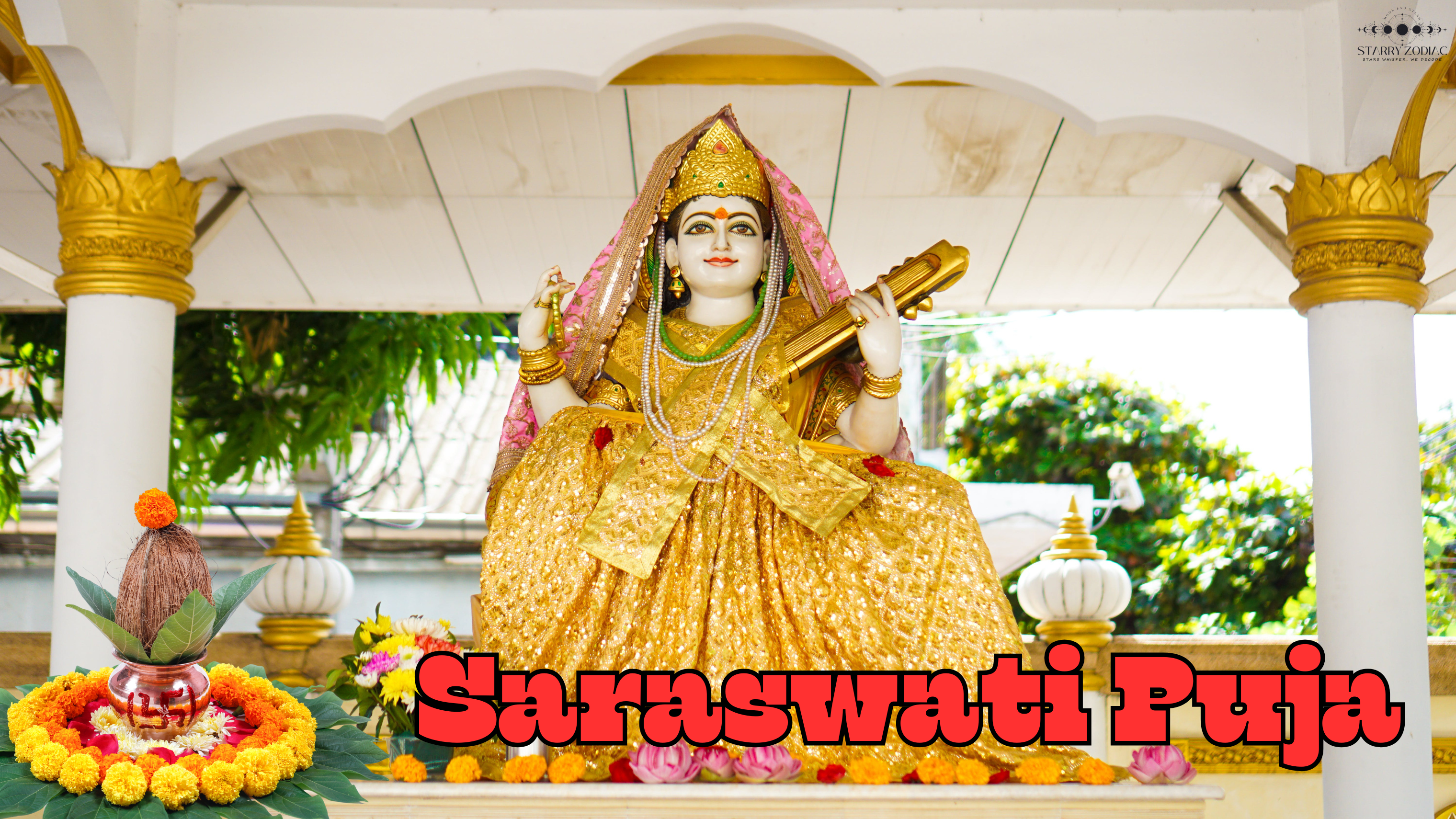
Basant Panchami, also known as Saraswati Puja, marks the arrival of spring and is a day dedicated to worshipping Goddess Saraswati, the deity of knowledge, wisdom, and arts. This festival is celebrated with great fervor across India, especially in schools, colleges, and households, as people seek the blessings of the goddess for learning and enlightenment. A vital aspect of this auspicious day is preparing traditional dishes that are not only delicious but also deeply rooted in cultural significance. In this article, we present 6 traditional homemade recipes for Saraswati Puja, each of which adds a festive flavor to your celebrations while honoring the spirit of Basant Panchami in 2025.
Table of Contents
Meethi Chawal (Sweet Rice) recipe
Here’s a simple Meethi Chawal (Sweet Rice) recipe, one of the most famous homemade recipes for Saraswati Puja:
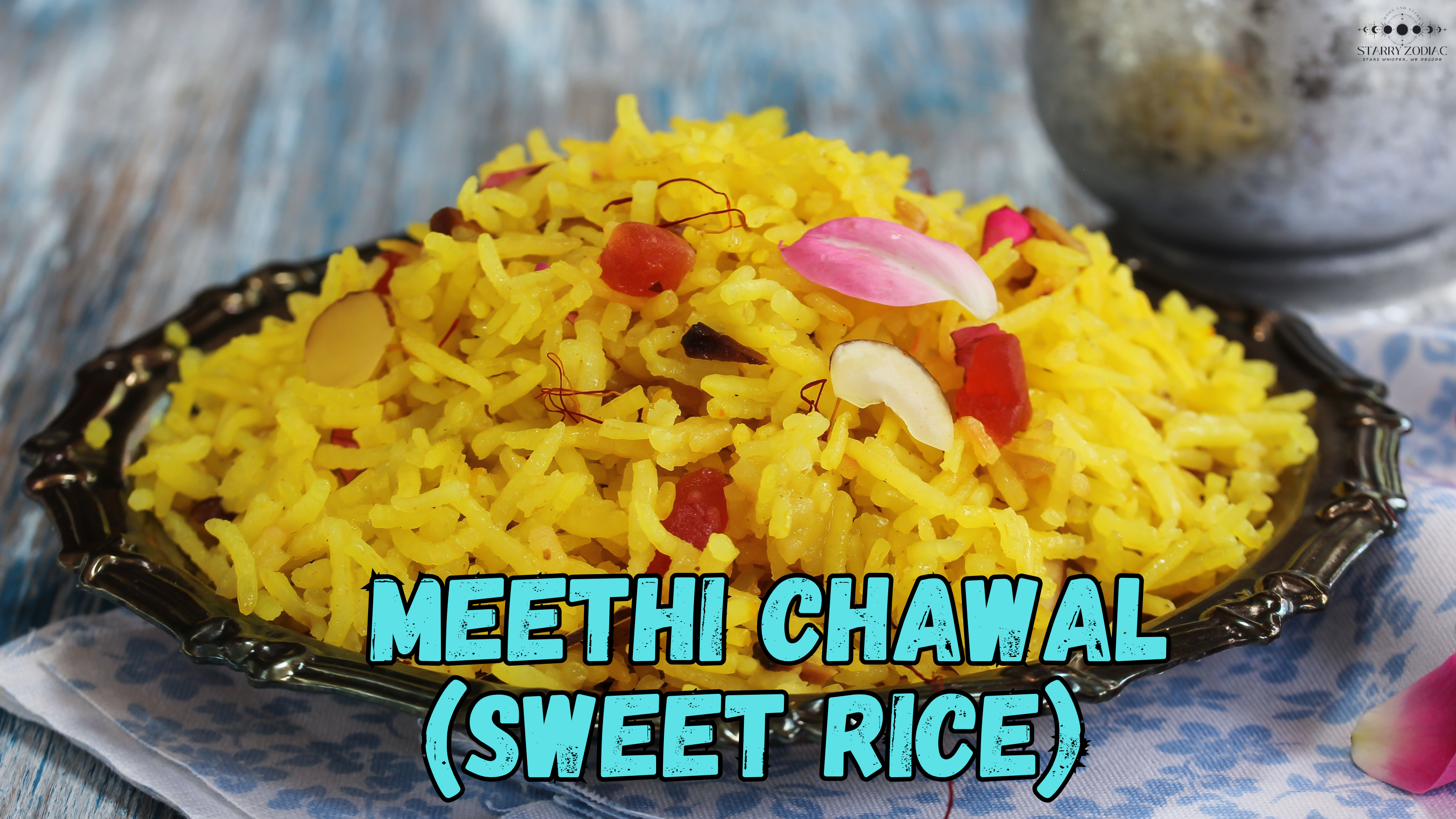
Ingredients:
- Basmati rice: 1 cup
- Water: 2 cups
- Sugar: 1/2 to 3/4 cup (adjust based on sweetness preference)
- Ghee (clarified butter): 2-3 tablespoons
- Cardamom powder: 1/2 teaspoon
- Saffron strands: A pinch (soaked in 2 tablespoons warm milk)
- Dry fruits (optional): 2 tablespoons (cashews, almonds, raisins)
- Cloves: 2-3 (optional, for fragrance)
- Yellow or orange food color: A pinch (optional)
Instructions:
- Wash and Soak Rice:
- Rinse the rice thoroughly in water until it runs clear.
- Soak the rice in water for about 30 minutes. Drain and set aside.
- Cook the Rice:
- Boil 2 cups of water in a pot.
- Add the drained rice and cook until 90% done (the grains should be tender but not mushy).
- Drain any excess water and keep the rice aside to cool slightly.
- Prepare the Sweet Mixture:
- In a small bowl, dissolve the saffron strands in warm milk. Add the food color (if using).
- Cook Meethi Chawal:
- Heat ghee in a pan or pot on medium heat.
- Add cloves (optional) and sauté for a few seconds until aromatic.
- Stir in sugar and 1/4 cup of water. Let the sugar dissolve completely.
- Add the saffron milk mixture and cardamom powder. Mix well.
- Combine with Rice:
- Add the cooked rice to the pan with the sugar syrup.
- Gently mix so the syrup coats the rice evenly.
- Cover and cook on low heat for 5-7 minutes, allowing the rice to absorb the sweetness.
- Add Dry Fruits:
- In a small pan, heat 1 tablespoon of ghee and lightly roast the dry fruits until golden.
- Add the roasted dry fruits to the sweet rice and mix gently.
- Serve:
- Garnish with more dry fruits or a few saffron strands.
- Serve warm or at room temperature.
Boondi Ladoo recipe
Here’s a simple Boondi Ladoo recipe, another one of the most famous homemade recipes for Saraswati Puja majorly in Northern India.
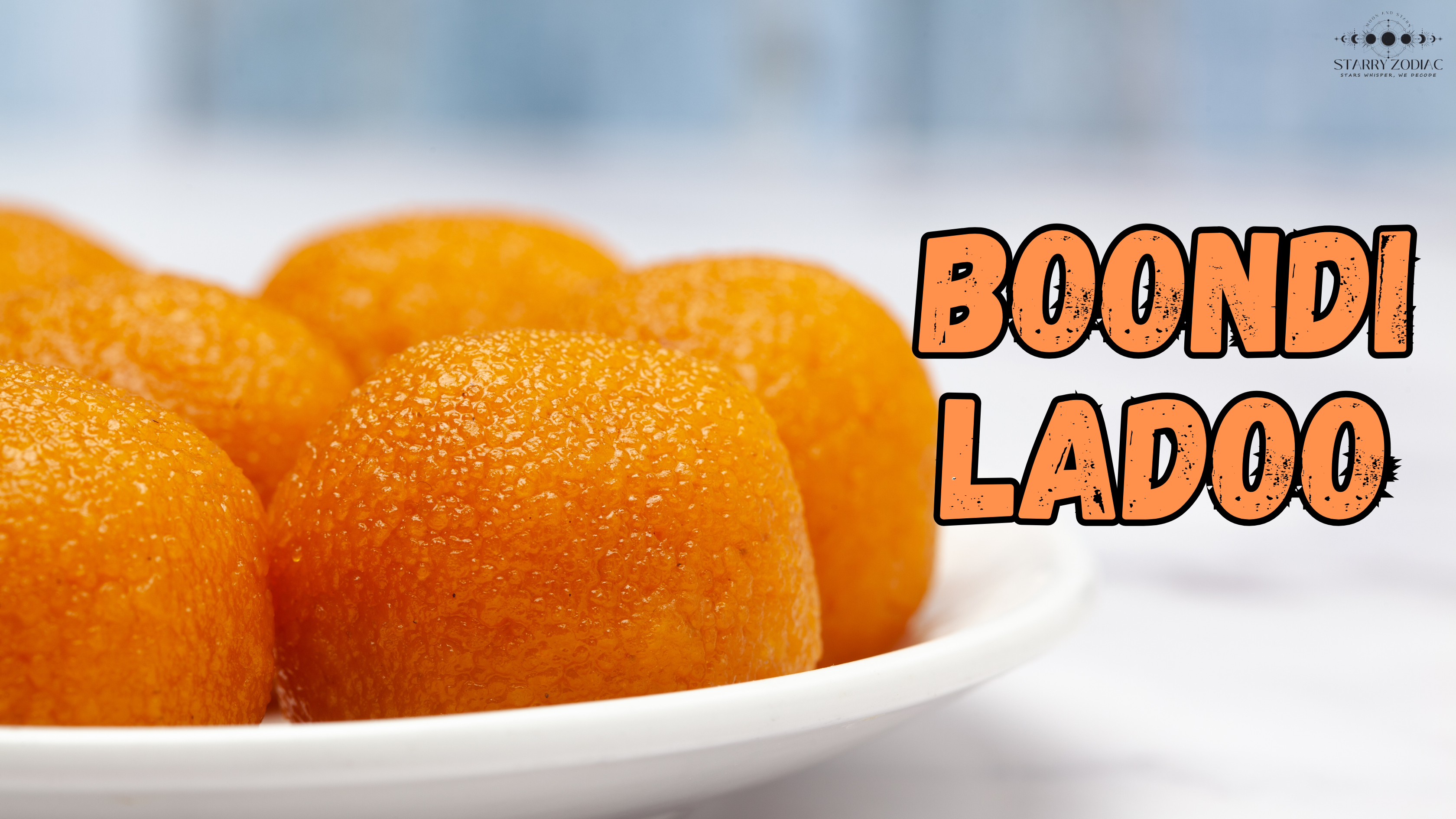
Ingredients:
For the Boondi:
- Besan (gram flour): 1 cup
- Water: Add gradually to reach the desired thickness of the batter.
- Yellow/orange food color: A pinch (optional)
- Ghee or oil: For deep frying
For the Sugar Syrup:
- Sugar: 1 cup
- Water: 1/2 cup
- Cardamom powder: 1/2 teaspoon
- Saffron strands: A few (optional)
- Rose water: 1 teaspoon (optional)
For Garnish (optional):
- Chopped dry fruits: 2 tablespoons (almonds, cashews, pistachios)
- Melon seeds: 1 tablespoon
Instructions:
Step 1: Prepare the Boondi
- Make the Batter:
- In a bowl, mix besan with water to make a smooth batter (not too thick or too runny). Add a pinch of food color if desired.
- The batter should be of flowing consistency, similar to dosa batter.
- Fry the Boondi:
- Heat ghee or oil in a deep pan on medium flame.
- Hold a perforated ladle (jhaara) over the hot oil. Pour a small amount of batter onto the ladle and let it drip through the holes into the oil.
- Fry the boondi until light golden and crisp.
- Repeat until all the batter is used.
Step 2: Make the Sugar Syrup
- In a pan, combine sugar and water. Cook on medium heat until the sugar dissolves and the syrup reaches a 1-string consistency (when a small drop of syrup between your fingers forms a single string).
- Add cardamom powder, saffron strands, and rose water to the syrup. Mix well.
Step 3: Combine Boondi with Sugar Syrup
- Add the fried boondi to the hot sugar syrup and mix well.
- Let the mixture cool slightly so it’s easier to handle but still warm.
Step 4: Shape the Ladoos
- Grease your palms with a little ghee. Take a small portion of the boondi mixture and shape it into round ladoos by pressing gently between your palms.
- Repeat with the remaining mixture. If the mixture dries out, sprinkle a little warm water to make it moist again.
Step 5: Garnish and Serve
- Press a few chopped dry fruits or melon seeds onto each ladoo for garnish.
- Let the ladoos cool completely and set before serving.
Enjoy your Boondi Ladoos during Saraswati Puja as a delightful prasad! 😊
Khichdi Recipe
Here’s a simple Khichdi Recipe recipe, one of the very common homemade recipes for Saraswati Puja, that’s comforting and easy to make. This dish is made with rice and lentils, cooked together with mild spices, and is highly versatile.
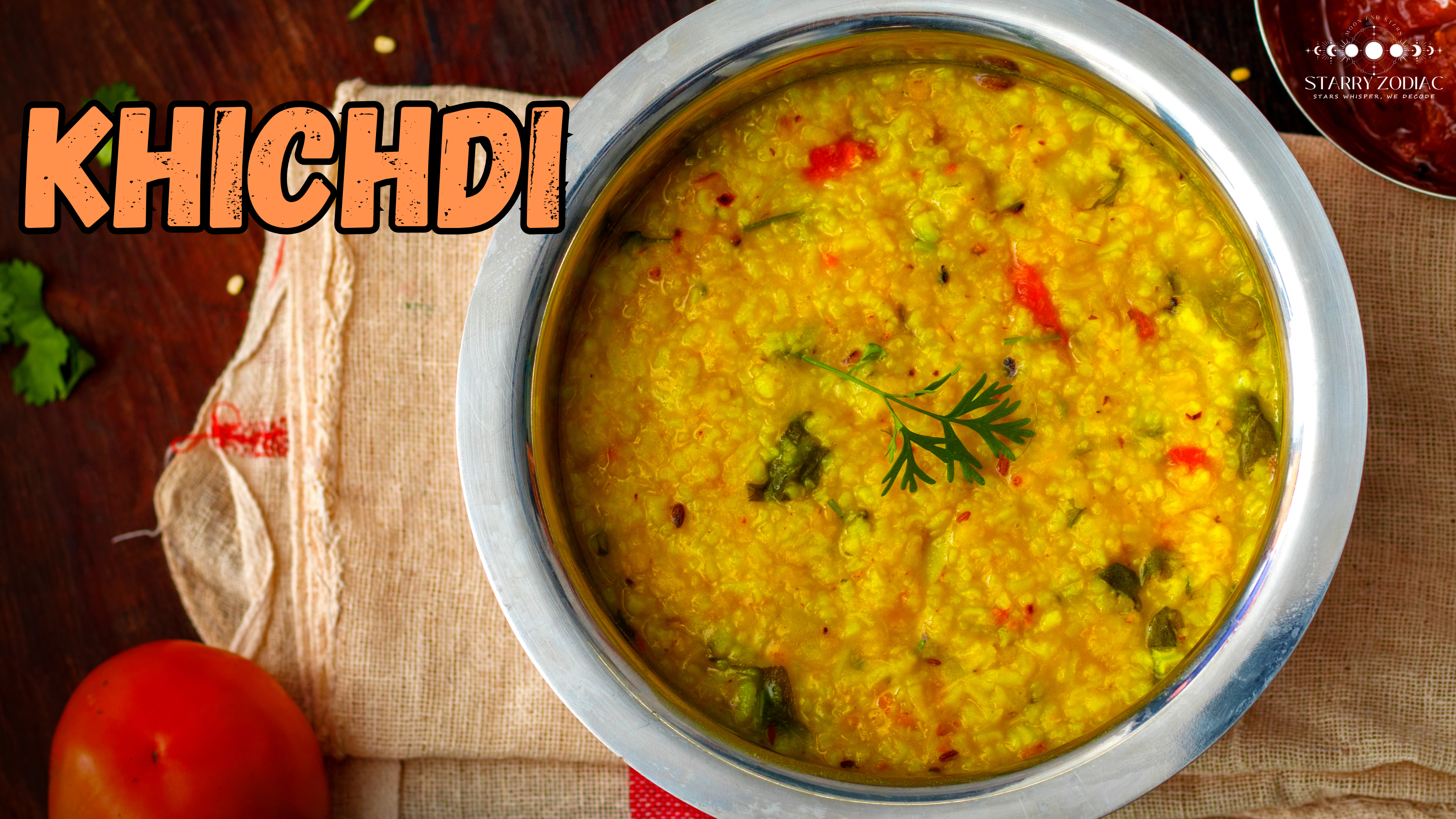
Ingredients:
- Rice: 1 cup (basmati)
- Yellow moong dal: 1/2 cup
- Ghee (clarified butter): 2-3 tablespoons
- Cumin seeds: 1/2 teaspoon
- Bay leaf: 1
- Turmeric powder: 1/2 teaspoon
- Vegetables (optional):
- Potatoes: 1 medium, cubed
- Carrots: 1 small, diced
- Green peas: 1/2 cup
- Cauliflower florets: 1/2 cup
- Salt: To taste
- Water: 4-5 cups (adjust depending on desired consistency)
- Asafoetida (hing): A pinch (optional)
- Garam masala (optional): 1/2 teaspoon (optional)
Instructions:
Step 1: Wash and Prep Ingredients
- Wash the rice and moong dal thoroughly and soak them in water for 20-30 minutes. Drain before cooking.
- Chop vegetables if using them.
Step 2: Roast the Moong Dal (Optional)
- Heat a dry pan and lightly roast the moong dal until aromatic and slightly golden. This step enhances the flavor.
Step 3: Cook the Khichdi
- Heat ghee in a pressure cooker or a large pot.
- Add cumin seeds and let them splutter. Add the bay leaf, and a pinch of asafoetida (hing).
- Add the chopped vegetables (if using) and sauté for 2-3 minutes.
Step 4: Add Rice and Lentils
- Add the drained rice and moong dal to the pot. Stir gently to coat the grains in the ghee and spices.
- Add turmeric powder and salt, and mix well.
Step 5: Add Water and Cook
- Add 4-5 cups of water, depending on whether you want a thicker or runnier consistency.
- If using a pressure cooker, cook for 2-3 whistles on medium heat. If cooking in a pot, cover and simmer on low heat for 20-25 minutes, stirring occasionally, until the rice and dal are soft.
Step 6: Final Touch
- Once cooked, mash the khichdi slightly for a creamy texture.
- Adjust salt if needed, and sprinkle garam masala (optional) for added flavor.
- Drizzle a little extra ghee on top before serving.
Serving Suggestions:
- Serve hot with papad, pickle, or a dollop of yogurt (curd).
This Khichdi is wholesome, nutritious, and perfect as comfort food. It’s light on the stomach and great for all ages! 😊
Moong Dal Halwa
Here’s a simple Moong Dal Halwa recipe, a rich and indulgent dessert often prepared for Saraswati Puja and other festive occasions.
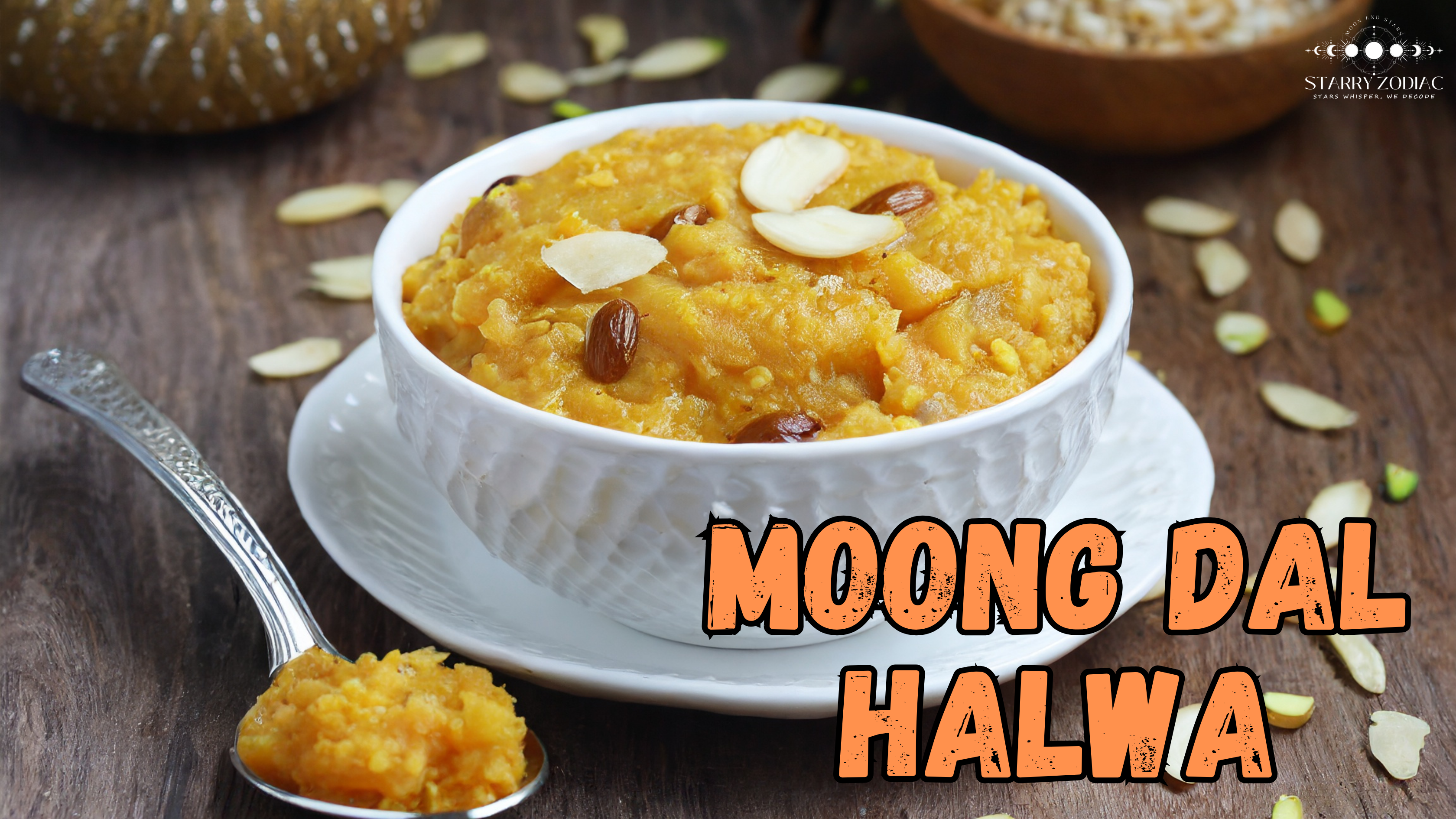
Ingredients:
- Yellow moong dal: 1 cup
- Ghee (clarified butter): 1/2 cup
- Milk: 2 cups
- Water: 1 cup
- Sugar: 1 cup
- Cardamom powder: 1/2 teaspoon
- Saffron strands: A small pinch, soaked in 2 tablespoons of warm milk to release the color and aroma.
- Chopped nuts (almonds, cashews, pistachios): 2-3 tablespoons
- Raisins: 1 tablespoon (optional)
Instructions:
Step 1: Soak and Grind the Moong Dal
- Rinse the yellow moong dal thoroughly and soak it in water for 3-4 hours.
- Drain the water and grind the soaked dal into a coarse paste without adding too much water. The paste should have a slightly grainy texture.
Step 2: Cook the Moong Dal Paste
- Heat ghee in a heavy-bottomed pan or kadhai on medium heat.
- Add the moong dal paste and start cooking it, stirring continuously to avoid lumps.
- Keep stirring and cook the paste until it turns golden brown and releases a nutty aroma. This process may take 20-25 minutes, so be patient.
Step 3: Prepare the Milk and Sugar Mixture
- In a separate pan, heat the milk, water, and sugar together. Stir until the sugar dissolves completely.
- Add the saffron-soaked milk to the mixture and mix well.
Step 4: Combine the Milk Mixture with the Dal
- Slowly pour the milk and sugar mixture into the cooked moong dal paste, stirring continuously to prevent lumps.
- Be cautious, as the mixture may splatter. Keep stirring as the dal absorbs the liquid.
Step 5: Add Flavor and Nuts
- Once the halwa thickens and starts leaving the sides of the pan, add cardamom powder and mix well.
- Add the chopped nuts and raisins, saving some for garnish.
Step 6: Final Touch
- Cook the halwa until it reaches your desired consistency and ghee starts oozing out from the sides.
- Remove from heat and garnish with the reserved nuts.
Serving Suggestions:
- Serve the Moong Dal Halwa warm as a prasad or dessert for Saraswati Puja.
- You can pair it with puris or enjoy it on its own.
This Moong Dal Halwa is a decadent, flavorful dessert, perfect for celebrating the festive spirit! 😊
Pakoda Kadhi
Here’s a simple Pakoda Kadhi recipe, one of the most famous homemade recipes for Saraswati puja, a delicious yogurt-based curry with gram flour fritters.
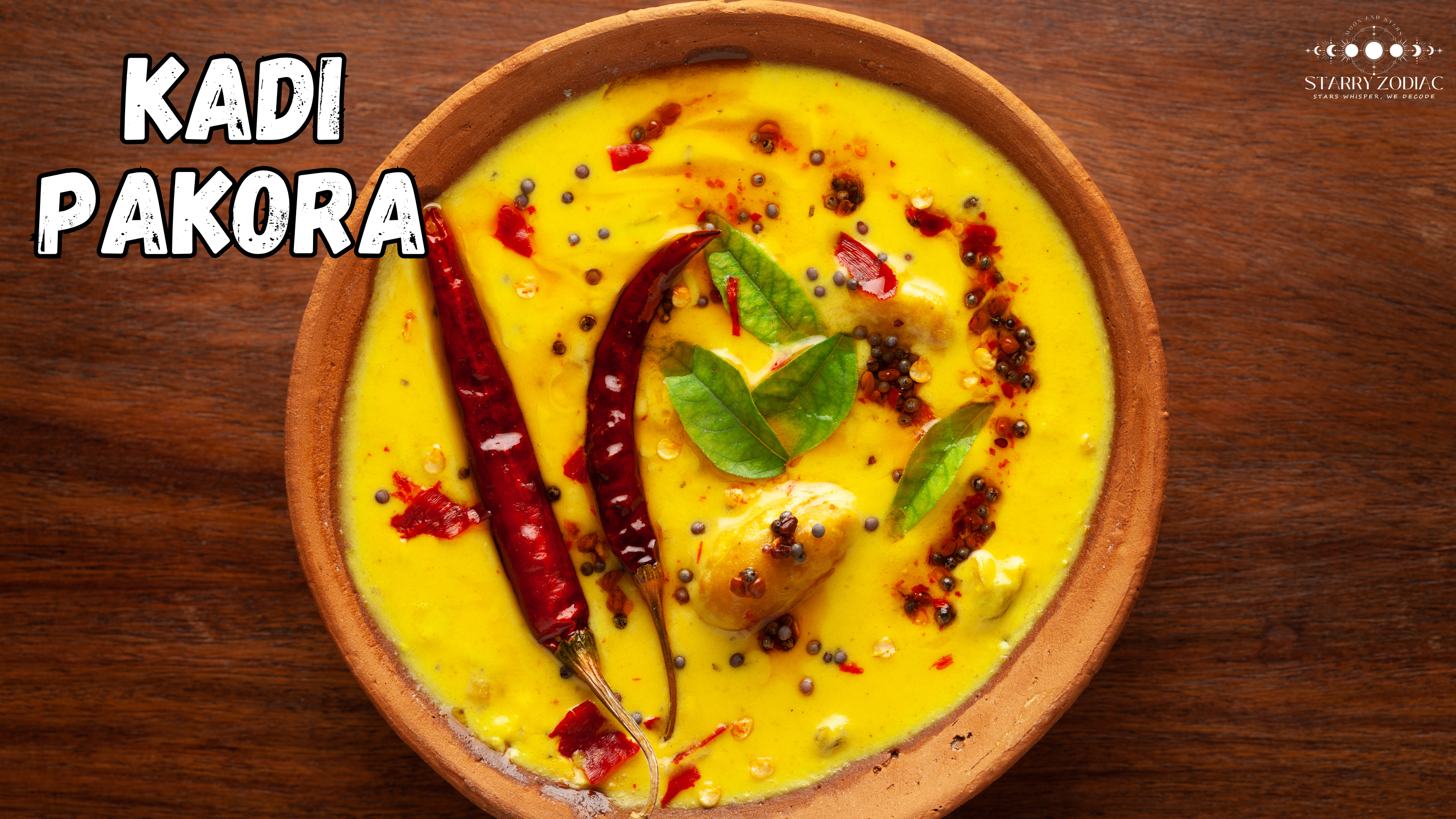
Ingredients:
For the Kadhi:
- Yogurt (curd): 2 cups
- Gram flour (besan): 2 tablespoons
- Water: 4 cups
- Turmeric powder: 1/2 teaspoon
- Red chili powder: 1/2 teaspoon
- Salt: To taste
- Ghee or oil: 2 tablespoons
- Mustard seeds: 1/2 teaspoon
- Cumin seeds: 1/2 teaspoon
- Fenugreek seeds (methi): 1/4 teaspoon
- Asafoetida (hing): A pinch
- Curry leaves: 8-10
- Dry red chilies: 1-2
For the Pakoras:
- Gram flour (besan): 1 cup
- Onion (finely chopped): 1 medium (optional, for non-traditional)
- Coriander leaves: 2 tablespoons, finely chopped
- Green chilies: 1-2, finely chopped
- Carom seeds (ajwain): 1/4 teaspoon
- Salt: To taste
- Water: for making of batter
- Oil: For deep frying
Instructions:
Step 1: Make the Pakoras
- Prepare the Batter:
- In a mixing bowl, combine besan, chopped onions (if using), coriander leaves, green chilies, carom seeds, and salt.
- Add water slowly to form a thick batter.
- Fry the Pakoras:
- Heat oil in a deep pan or kadhai over medium heat.
- Drop smaller portions of the batter into the hot oil.
- Fry until the pakoras are crispy golden brown. Remove and drain on paper towels.
Step 2: Prepare the Kadhi
- Whisk the Kadhi Mixture:
- In a large bowl, whisk the yogurt, besan, water, turmeric powder, red chili powder, and salt until smooth and lump-free.
- Cook the Kadhi:
- Heat ghee or oil in a large pot.
- Add mustard seeds, cumin seeds, fenugreek seeds, asafoetida, curry leaves, and dry red chilies. Let them splutter.
- Pour the yogurt-besan mixture into the pot and bring it to a boil over medium heat, stirring continuously to prevent curdling.
- Once it boils, reduce the heat and simmer for 15-20 minutes, stirring occasionally, until the kadhi thickens slightly.
Step 3: Add Pakoras to the Kadhi
- Add the pakoras in kadhi.
- Let the pakoras soak in the kadhi for 5-7 minutes so they absorb the flavors and become soft.
Step 4: Final Tempering (Optional)
- Heat a teaspoon of ghee or oil in a small pan.
- Add 1/2 teaspoon red chili powder and pour this tempering over the kadhi for an extra burst of flavor.
Serving Suggestions:
- Serve the Pakoda Kadhi hot with steamed rice or jeera rice.
- Pair it with a side of papad and pickle for a complete festive meal.
This flavorful Pakoda Kadhi is a delightful offering for Saraswati Puja, combining the goodness of yogurt and the crispiness of pakoras. Enjoy! 😊
Kesariya Sheera
Here’s a recipe for Kesariya Sheera (also known as Kesari or Suji Halwa), another one of the most delicious homemade recipes for Saraswati Puja, a rich and aromatic Indian dessert made with semolina, ghee, and flavored with saffron.
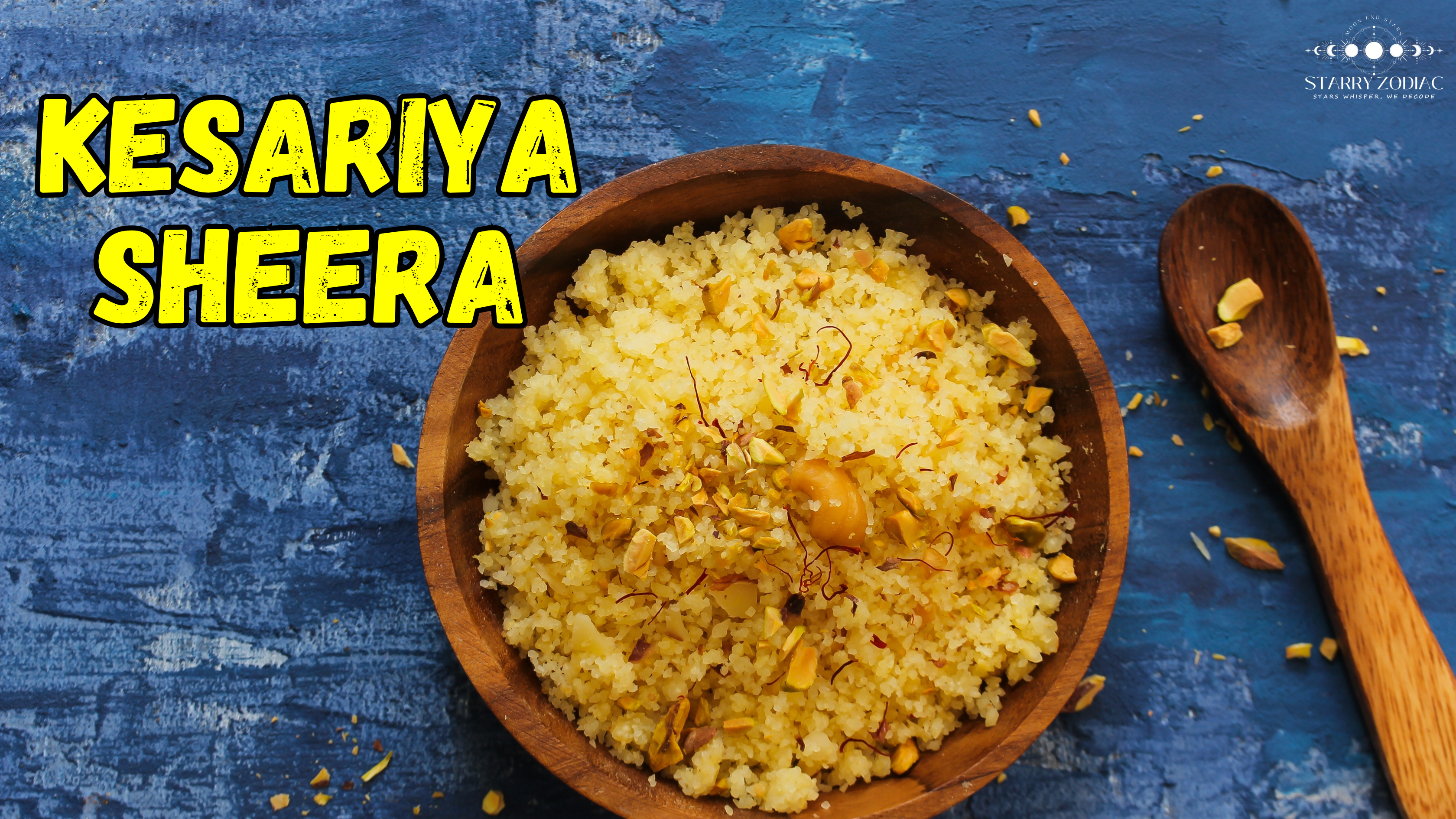
Ingredients:
- Semolina (suji): 1 cup
- Ghee (clarified butter): 1/4 cup
- Sugar: 1 cup (adjust to taste)
- Water: 2 cups
- Milk: 1/2 cup
- Saffron strands: A pinch (soaked in 2 tablespoons warm milk)
- Cardamom powder: 1/2 teaspoon
- Chopped nuts (cashews, almonds, pistachios): 2 tablespoons
- Raisins: 1 tablespoon
- Rosewater: 1 teaspoon (optional)
- Pinch of yellow food color (optional for extra color)
Instructions:
Step 1: Prepare the Saffron Milk
- Soak the saffron strands in 2 tablespoons of warm milk and set aside. This will infuse the milk with the rich color and fragrance of saffron.
Step 2: Roast the Semolina
- Heat ghee in a heavy-bottomed pan on medium heat.
- Add the semolina (suji) and roast it, stirring continuously, until it turns golden brown and releases a nutty aroma. This may take about 5-7 minutes. Be careful not to burn it.
Step 3: Prepare the Sugar Syrup
- In a different pan, mix water, milk, and sugar together. Heat the mixture until it boils, stirring constantly until the sugar is fully dissolved.
- Once the sugar has dissolved, add the saffron milk and cardamom powder. Optionally, you can also add a pinch of yellow food color for a more vibrant look.
Step 4: Combine the Syrup with the Roasted Semolina
- Once the sugar syrup is ready, gradually pour it into the roasted semolina, stirring continuously to avoid lumps.
- Cook the mixture on low heat until the semolina absorbs the syrup and thickens. This will take about 5-7 minutes.
- If the sheera becomes too thick, you can add a little more milk or water to adjust the consistency.
Step 5: Add Nuts and Raisins
- Add chopped nuts and raisins to the sheera, stirring them in to distribute evenly. You can also add a little more ghee for richness at this stage.
- Continue cooking for another 2-3 minutes until the nuts are slightly toasted and the sheera is smooth and well-combined.
Step 6: Serve
- Serve the Kesariya Sheera hot, garnished with more chopped nuts if desired.
Serving Suggestions:
- Kesariya Sheera can be served as prasad during Saraswati Puja or enjoyed as a dessert after meals.
- You can serve it with puris or just as a stand-alone dish.
This Kesariya Sheera is aromatic, flavorful, and a perfect festive treat, bringing a touch of sweetness and warmth to your celebrations! 😊
This Basant Panchami, bring a taste of tradition to your festivities with these delectable homemade recipes for Saraswati Puja. Each dish is a tribute to the rich cultural heritage of the occasion, ensuring that your offerings to Goddess Saraswati are both heartfelt and flavorful. Whether it’s the vibrant sweetness of kesar halwa or the nostalgic aroma of khichuri, these recipes connect us to the roots of our traditions. Let this Saraswati Puja 2025 be a time of joy, togetherness, and blessings, enriched by the warmth of homemade delights. Happy Basant Panchami!
“Your stars have a story to tell, and at Starry Zodiac, we’re here to help you uncover it. From detailed daily horoscopes to astrological insights and the rich traditions of Hindu festivals, we bring you everything you need to navigate life with cosmic guidance. Explore the wonders of the zodiac and discover how the universe aligns for you. Visit Starry Zodiac today and let the stars lead the way!”
